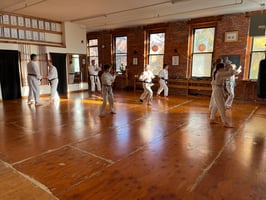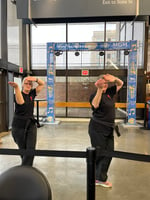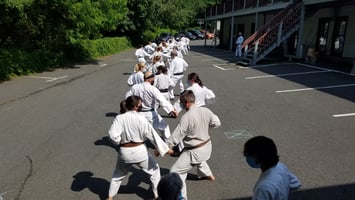As we come up to 2025, lots of folks will think about New Year's resolutions.
Some brief thoughts on 'Karate and Zen as one'
O-Sensei Shoshin Nagamine’s book, Tales of Okinawa’s Great Masters, delivers on the title by introducing the reader to some of the most influential figures in the development of modern-day Okinawan karate.
His real achievement, though, is to give us not just biographical details, but to trace the development of some key intellectual and ethical beliefs that make karate so much more than fancy brawling.
Throughout the book, he names and links three concepts:
shingitai ichinyo (spirit and technique are one)
bun bu ryo dō (harmony between pen and sword, or linking physical and philosophical elements into one course of study)
ken zen ichinyo (karate and zen as one)
These sayings are iterations of concepts that build on each other, interlock with each other, and are in conversation with each other. With the caveat that we are working from translations, the first saying feels more elemental, the second more intellectual, and the third more spiritual. What they all share, however, is that the physical, fighting aspects of karate (and its predecessors) must be balanced with an intellectual and moral/spiritual engagement in one’s practice.
It’s not just about hitting hard and kicking hard; that’s not enough to be considered a true master. I think Nagamine wants us to understand the how the techniques work intellectually. I think he wants us to bring an intense, dedicated focus to our practice of those techniques. And I think he wants us to be aware of what it means to deploy these moves against another human being.
In Chapter 5 of his book, in the section entitled “Revealing the Truth of Karate-Do”, Nagamine writes:
“There can be no question that martial arts first ascended from man’s instinct to defend himself. However, the body of moral philosophy established to govern the behavior of those who master the secrets of martial arts… elevated the discipline from a form of common brutality (killing fist) to a sophisticated vehicle through which to enhance the living of life itself (living fist)”
We get at this idea in popular culture through the stereotype of the meditating warrior (think Patrick Swayze doing tai chi AND knocking heads together in Road House).
But Nagamine wants us to go deeper than the “dude who hits well because he can be chill” idea — and I think this is why he is more explicitly spiritual with his formulation of “ken zen ichinyo”. He wants us to see how this concept of karate transcends martial arts and can shape a better life.
He writes in Chapter 12, in the section entitled “Dedicated to Seeking Ken Zen Ichinyo”:
“In my lifetime I came to learn the significance of “ken zen ichinyo.” Having learned the spiritual essence of karate-do through embracing the true precepts of shingitai, I am a true advocate of Zen, a tradition which has a 2500 year history. I believe that the value of mastering karate lies not in physical superiority, but rather social pliability — learning to live in harmony with nature and one’s fellow man rather than frivolously trying to dominate or destroy.”
Most of us at Northampton Karate are not Buddhist like O-Sensei was — but I don’t think we have to be in order to take inspiration from his words and to strive to use what we learn in our practice to make a more harmonious existence for ourselves.



